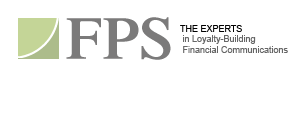 |
 |
| OCTOBER 2009 |  |
What we do |  |
Work Samples |  |
FPS Resource Library |
|
Is Compliance Keeping You Away from Social Media? In the many articles, blogs and surveys pertaining to banks and social media, there are some key issues that continue to be at the forefront. Reasons to use social media Statistics show that the majority of purchasers on social media sites are business-to-business (B2B) buyers. The informality and two-way dialogues of social media are conducive to trust and relationship-building. Social media is also the preferred information channel for younger consumers of commercial services. And many banks are using social media channels to reach out to these younger consumers to forge relationships that will only become more profitable as these consumers mature. For example, Wells Fargo, American Express and Bank of the Southwest have been dabbling in social media in an effort to target 18- to 35-year-olds. Social media "connects to and speaks to younger consumers," explains Josh Ragsdale, Head of Marketing for Bank of the Southwest. "My generation doesn't call customer service." Instead, they research the Web, he says. Bank of America has launched a small business banking community that has attracted over 15,000 members. Here customers can chat with other entrepreneurs and business owners or just post useful articles. Alan Maginn, Senior Analyst for Corporate Insight, a financial services research firm, points out that "the bank is learning from clients while at the same time extending its brand." Social media has proven to be a channel that has delivered much greater marketing efficiency during the current economic downturn, notes Marcy Shinder, Vice President-Brand Strategy and Marketing for American Express OPEN. A social media site created by American Express called "OPENForum" provides small businesses with content and tools that can help them grow their business, Ms. Shinder told an August meeting of B2B national advertisers. She likes the fact that the OPENForum initiative costs exponentially less than traditional media and is more of a pull than a push marketing strategy. While noting that American Express has scaled back its TV advertising, she says shifting from expensive TV executions to digital and social media channels "is not just about cost; it's about what people are responding to." The flip side of the coin We all know social media is growing and B2B companies are jumping on more business-oriented social media sites, such as LinkedIn, Biznik, etc., with many such sites maintaining blogs that allow B2B marketers to post content. Both B2B vendors and consumers are enthralled with the open exchange of ideas, the support and advice that can be freely shared, and the unprecedented networking opportunities. Unfortunately, however, social media presents some daunting challenges to B2B providers in the financial services industry. The unique challenge in finance is keeping all communication safely corralled within the boundaries of compliance. This explains why many banks are planning forays into B2B social media but relatively few have actually tested the waters. The informality and open exchanges inherent in social media are the very characteristics that can create compliance disasters that, unlike with most other media channels, cannot be remedied before the damage is done. When engaging in a free-wheeling discussion on a social media channel, it is too easy to inadvertently violate compliance rules and regulations that banks and other financial service providers have set for themselves. For example, a common requirement that all financial advice be subjected to prior review virtually precludes using B2B social media to promote new products or services. The very nature of a sales-oriented message is in and of itself a violation of most bank compliance requirements. Indeed, compliance requirements also make it difficult for banks and other financial service providers to participate in B2B social media. For instance, original thought-provoking content that could attract wide readership will be subject to stricter compliance review that might delay its posting. "Depending on the policies and procedures of your compliance department, writing original articles may be more of a headache than it's worth," says Kristen Luke, who writes a Social Media Marketing blog. Luke adds that articles ghostwritten by third parties that address issues unrelated to bank products and services would not be subjected to compliance review. Having such content produced by an outsource provider might be an attractive option for bankers or financial service providers who don't like to write, don't have the time to write, or who must deal with strict compliance policies that are likely to significantly delay postings specifically related to institution-related products and services. The happy 'medium' So how can banks avoid potential land mines while partaking of the fruit of this new media? One way is to re-purpose informative content that has already been approved by compliance. Newsletters, white papers and case studies — if created in the informative and objective format intended for these outlets — can be of high interest to certain target groups. LinkedIn features thousands of "groups" on its social media site that you can target and join. For instance, a search engine query of the term "CFO" revealed 321 groups. Since these pre-published forms of content have already been approved by compliance reviewers, they can be posted on social media as a means for bankers to participate in timely discussions. Within your group(s) — in LinkedIn or in some other B2B social media — you can post discussions or news items taken from existing collateral and ask for questions or comments. Over time, such postings establish you and your bank as thought leaders in your peer group. Another option is to post a summary of a newsletter article or news item and include a link to the full story. This has proven to boost newsletter sign-ups among those who click through to the content. Finally, many social media sites, like LinkedIn, sell advertising that includes guaranteed placement on relevant group sites. These postings also can be linked to a special landing page or other "dangling carrot" content in order to draw the reader further into your marketing "lair." . . . If you are not already a MarketScope subscriber, please request your own free monthly edition. |
